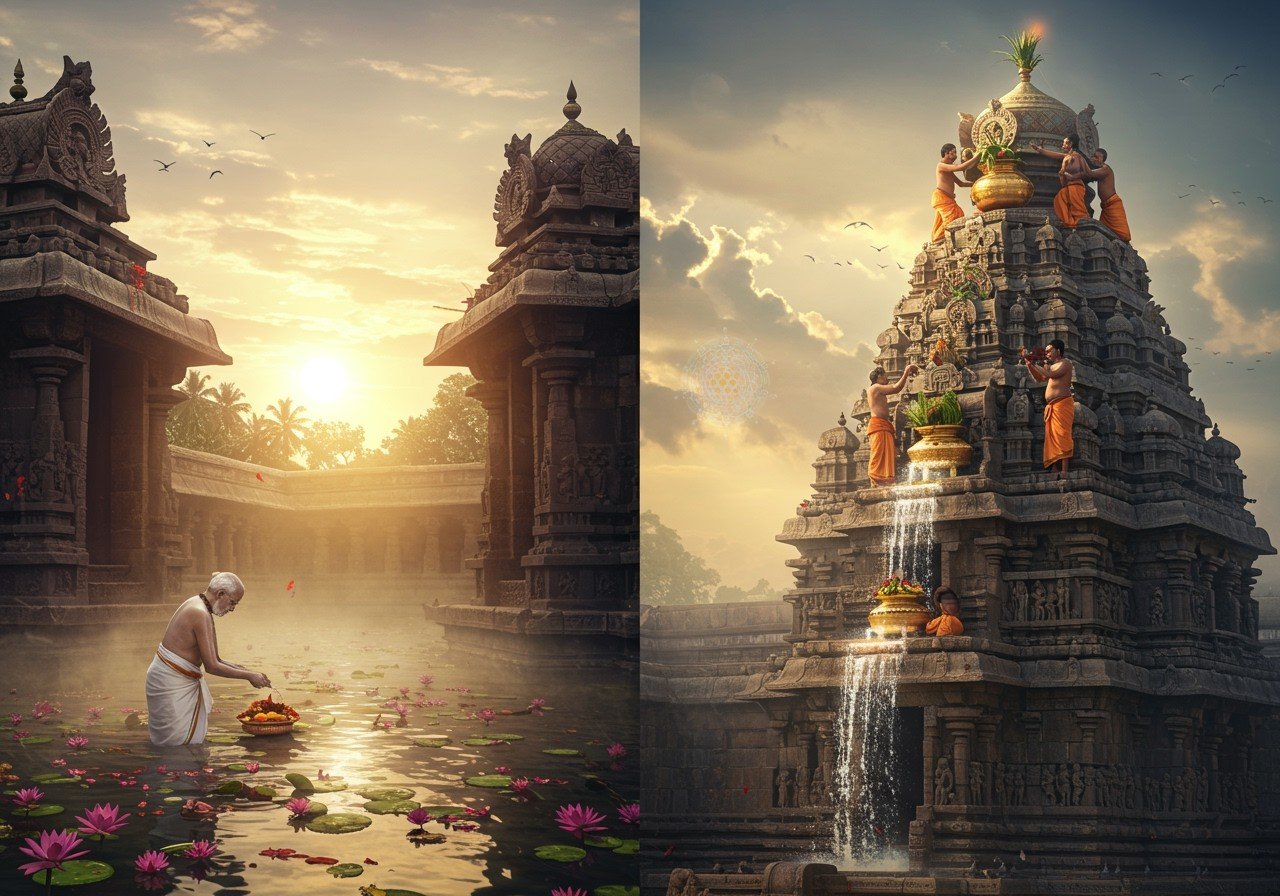Delving into the Sacred: Tharpanam and Kumbabishekam at Sri Sivan Temple

The rituals of Tharpanam and Kumbabishekam hold deep significance in Hindu temple practices. They are essential for connecting with the divine and preserving cultural heritage. At Sri Sivan Temple, these ceremonies are a blend of spirituality and tradition. With the ease of online shopping, devotees can now engage more conveniently with these practices. You can find authentic puja items on Poojn.in.
Understanding Tharpanam
Tharpanam is a sacred ritual performed to honor our ancestors. It involves offering water and sesame seeds to departed souls, seeking their blessings for prosperity and well-being. In Hindu mythology, water symbolizes purity, while sesame seeds represent nourishment for the departed. At Sri Sivan Temple, the Tharpanam ceremony includes preparing the altar, invoking deities, and making the offerings with reverence. The spiritual benefits of performing Tharpanam are believed to include removing ancestral curses and ensuring the well-being of future generations.
Would you like to perform Tharpanam at home? Poojn.in offers all the necessary items.
Sri Sivan Temple Tharpanam
At Sri Sivan Temple, the Tharpanam ritual reflects the temple’s rich historical significance, creating a palpable sense of connection to the past. The architectural features of the temple enhance the spiritual atmosphere, making the ceremony even more profound. Specific days and timings are designated for the ritual, guided by the wisdom of the temple priests. Local customs, including special prayers and chants unique to the region, add to the ritual’s distinctive character. The active participation of the community underscores the temple’s cultural importance, fostering a sense of unity and shared devotion.
Understanding Kumbabishekam
Kumbabishekam is a grand ceremony that rejuvenates and sanctifies temples. It involves pouring sacred water, often from a specially prepared pot known as a Kumbam, over the temple tower, also known as the Gopuram or Vimanam. This act is believed to energize the temple and its presiding deities. The preparations for Kumbabishekam are extensive, including purifying the temple premises, invoking deities, and performing sacred fire rituals. The creation of the Kumbam itself is a sacred process involving the recitation of mantras and the infusion of divine energy into the water. This ceremony is vital for maintaining the sanctity of the temple and enhancing the spiritual experiences of devotees.
For all your Kumbabishekam needs, visit Poojn.in.
Sri Sivan Temple Kumbabishekam
The Kumbabishekam at Sri Sivan Temple is a magnificent spectacle. The intricately carved Gopuram becomes the focal point of the ceremony, symbolizing the connection between the earthly and divine realms. The active involvement of the community fosters a sense of unity and shared spiritual growth. The ceremony’s unique aspects include special prayers and cultural performances that reflect the rich traditions of the region. Meticulous logistical arrangements are made to ensure the safety and comfort of the large number of devotees who gather for this auspicious occasion.
Modern Convenience in Traditional Rituals
The digital age is transforming how we approach traditional rituals, making them accessible to people across the globe. Online platforms provide access to authentic ritual items, allowing devotees to participate in ceremonies like Tharpanam and Kumbabishekam with greater convenience. This accessibility doesn’t compromise authenticity; rather, it offers a way to connect with tradition in our modern lives. Virtual participation options ensure inclusivity, enabling those unable to physically attend temple ceremonies to connect with their faith. Maintaining authenticity is crucial even with modernization, and balancing tradition with the conveniences of modern life helps preserve our rich cultural heritage. Explore authentic ritual items at Poojn.in.
The Essence of Hindu Temple Ceremonies
Hindu temple ceremonies are a vibrant tapestry of faith, woven with threads of devotion, tradition, and community. They are more than just rituals; they are a living link to the divine, breathing life into the spiritual heart of Hinduism. From the daily puja to grand events like Kumbabishekam, these ceremonies nourish the soul and connect us to something larger than ourselves.
Purpose and Significance
- Home for Deities: Temples are revered as the homes of the gods, places where the divine presence is palpable. They are sanctuaries where devotees seek blessings, solace, and connection with the divine. They are powerful places where the divine and human worlds intersect.
- Darshan: The concept of darshan, seeing and being seen by the deity, is central to temple worship. This visual connection is believed to bestow blessings and grace, offering a direct experience of the divine. It is a moment of profound spiritual connection, where the devotee feels seen and acknowledged by the divine.
- Community and Tradition: Temples serve as vital community centers, fostering a sense of belonging and shared faith. They are spaces where ancient rituals are preserved, artistic performances are showcased, and traditions are passed down through generations, bridging history and modern life. They are the heart of the community, where people gather to celebrate, mourn, and connect with their shared heritage.
- Deepening Bonds: Temple ceremonies aim to deepen the individual’s connection with the divine through various expressions of devotion. From simple prayers to elaborate rituals, every act of worship strengthens this bond, fostering a sense of peace, purpose, and spiritual growth. They provide a pathway to experience the divine presence in a tangible way.
Common Elements of Temple Ceremonies
- Puja: Puja, the act of worship, is the heart of temple ceremonies. It can be a simple personal prayer or an elaborate ritual involving offerings, chanting, and sacred gestures. It’s a way of showing reverence, seeking blessings, and connecting with the divine on a personal level. The complexity of a puja can vary depending on the occasion and the specific deity being worshipped, but its essence remains the same: an expression of devotion and a seeking of divine grace.
- Arti (Aarti): The aarti ceremony, where lighted lamps are waved before the deity, is a powerful symbol of dispelling darkness and invoking blessings. This act of offering light is believed to purify the atmosphere and invite positive energy. The priest often takes the flame to the devotees, who pass their hands over it and then their eyes, symbolically receiving the blessings of the deity.
- Abhishekam: Abhishekam is a ritual bathing of the deity with sacred substances like milk, honey, water, and sandalwood paste. This act symbolizes purification and reverence. It’s believed to invoke the blessings of the deity and cleanse the temple environment, creating a space conducive to spiritual growth.
- Mantras: The chanting of mantras, sacred sounds and phrases, is integral to many temple ceremonies. These vibrations are believed to carry spiritual power, invoking specific deities and creating a resonant atmosphere. The rhythmic chanting of mantras is believed to purify the mind, create positive energy, and connect the individual with the divine.
- Offerings: Devotees offer a variety of items to the deity, including flowers, fruits, food, money, and clothing. These offerings are symbols of respect, devotion, and gratitude. They also represent a sharing of one’s resources with the divine, acknowledging the source of all abundance.
- Prasada: After the offerings are blessed by the deity, they are distributed to the devotees as prasada, sanctified food or items. Accepting and consuming prasada is considered a blessing, signifying the divine’s grace and connection with the devotee. It is a tangible reminder of the divine presence and a way to partake in the blessings of the ceremony.
- Prayer and Hymns: Prayers, hymns, and devotional songs are often recited or sung during temple ceremonies, expressing devotion, seeking blessings, and creating a sacred atmosphere. These expressions of faith can be traditional ancient prayers or spontaneous personal requests, each carrying the weight of the devotee’s heart.
- The Priest’s Role: Priests play a vital role in temple ceremonies, performing rituals for the deities, including dressing and feeding them. They act as intermediaries between the divine and the devotees, ensuring the smooth execution of the rituals. Their knowledge of scriptures and rituals helps guide the ceremonies and maintain the sanctity of the temple environment.
- Respectful Gestures: Devotees express respect through various gestures, like the anjali mudra (palms together), pranama (prostration), and holding their ears as a sign of humility or to ask for forgiveness. These gestures are outward expressions of inner reverence, humility, and the acknowledgment of the divine presence.
- Circumambulation (Parikrama): The act of circumambulation, walking around the altar, is a symbolic act of recognizing God as the center of one’s life. It is a way of showing reverence and acknowledging the pervasive presence of the divine in all aspects of existence.
Practices during a Temple Visit
- Removing Shoes: Removing shoes before entering the temple is a common practice, symbolizing respect, humility, and maintaining the cleanliness of the sacred space. This act of leaving the outside world behind signifies entering a space of reverence and spiritual purity.
- Ringing the Bell: Upon entering the shrine room, devotees often ring a bell. This act is believed to awaken the deities and signal the devotee’s presence, announcing their readiness to worship. The sound of the bell is also considered purifying, dispelling negative energies and creating a sacred atmosphere.
- Offerings: Offerings of food, flowers, and gifts are made to show respect to the deity and indicate the devotee’s worthiness of the gods’ attention. This act of giving is a sign of devotion and gratitude, acknowledging the divine as the source of all blessings.
- Silent Prayers: Devotees engage in silent prayers, either personal or traditional ancient prayers, seeking blessings, guidance, and connection with the divine. This quiet communion allows for a personal and intimate conversation with the divine, expressing one’s deepest hopes, fears, and desires.
- Receiving Blessings: Priests may offer vibhuti (sacred ash) or kumkum (vermillion paste) to apply to the forehead as a blessing. Holy water might also be sprinkled on the head or offered to drink as a symbol of purification. These acts are believed to carry the divine’s blessings and offer protection and spiritual upliftment.
Festivals and Special Occasions
- Unique Rituals: Each festival has its own unique rituals and customs related to the deity being celebrated. These rituals often involve special offerings, prayers, and celebrations, creating a vibrant atmosphere of devotion and joy. Festivals are a time for community gathering, spiritual renewal, and the celebration of the divine in its various forms.
- Community Gathering: Festivals are a time for communities to come together, strengthening bonds and celebrating shared beliefs. They are occasions for joyous celebration, reaffirming faith, and strengthening the social fabric of the community.
- Life Milestones: Temples often host important life events like weddings and naming ceremonies, preserving traditions and connecting these milestones to the divine. These ceremonies mark significant transitions in life, invoking blessings for a prosperous and fulfilling future.
Sri Sivan Temple beautifully exemplifies these practices, blending spirituality with cultural significance. Modern conveniences, like online platforms such as Poojn.in, now allow devotees to engage with these rituals more easily, ensuring accessibility while honouring tradition. Through these ceremonies, temples remain vibrant centres of faith, culture, and community.
Need help with your Tharpanam or Kumbabishekam preparations? Poojn.in offers expert guidance. Contact us for personalized recommendations.
FAQs on Temple Rituals: Tharpanam and Kumbabishekam
What is Tharpanam?
Tharpanam is a Hindu ritual performed to express gratitude and seek blessings from our ancestors. It involves offering water and black sesame seeds, symbolizing nourishment and purification, to the departed souls. This ritual is a way of remembering our ancestors and seeking their continued blessings for our well-being.
Why is Tharpanam important?
Tharpanam is considered important for maintaining a harmonious connection with our ancestors. It is believed to bring peace to their souls and ensure their continued support and guidance in our lives. This ritual also reinforces family ties and strengthens our sense of belonging within our lineage.
What is Kumbabishekam?
Kumbabishekam is a grand consecration ceremony performed for Hindu temples. It involves sanctifying the temple and its deities by pouring sacred water over the temple tower. This act of purification is believed to revitalize the temple’s spiritual energy and renew its connection with the divine.
Why is Kumbabishekam performed?
Kumbabishekam is essential for maintaining the sanctity and spiritual potency of a temple. It is believed to infuse the temple with divine energy, enhancing the positive vibrations and making it a more conducive space for worship and spiritual growth. This ceremony is performed to renew the temple’s spiritual power and reaffirm its role as a sacred space.
How often is Tharpanam performed?
Tharpanam is typically performed on specific auspicious days, such as Amavasya (new moon day), during the Mahalaya Paksha period, and on the anniversaries of ancestors’ passing. The frequency can vary based on family traditions and individual beliefs.
How often is Kumbabishekam conducted?
Kumbabishekam is a major event, usually conducted every 12 years for a temple. The timing can vary depending on the specific temple’s traditions and the astrological considerations determined by the temple priests. It is a grand celebration that draws devotees from far and wide.
Can Tharpanam and Kumbabishekam be done at home?
Tharpanam can be performed at home or at sacred water bodies, often with the guidance of a priest. However, Kumbabishekam is a large-scale temple ritual requiring the participation of priests and the community, and is typically not conducted at home.
Where can I witness Kumbabishekam and Tharpanam?
You can witness both Tharpanam and Kumbabishekam at temples like Sri Sivan Temple. These ceremonies are performed according to traditional practices, offering devotees a powerful spiritual experience. Check the temple’s schedule for specific dates and times.
Poojn.in offers a wide range of products for Hindu rituals. Learn more about Hindu rituals here.


